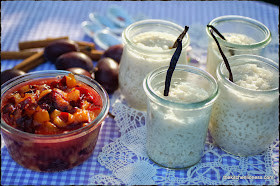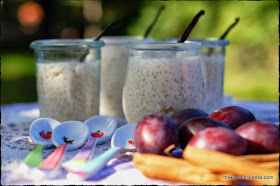Last September, I did a series on a few of my favorite cakes from Nigel Slater. First up was his delightful Black Banana Cake. That recipe made me forget all about my previous recipes for Banana Cake. Then we indulged in his Cinnamon Pear Cake with Vanilla Fudge Sauce. What a treat. And the third cake of the series was the Plum Pudding Cake that I baked with Reine Claude plums. Delightful.
|
Im September letzten Jahres habe ich eine Reihe meiner Lieblingskuchen von Nigel Slater gepostet. Als erstes war sein wunderbarer Bananen-Kuchen dran. Slaters Rezept hat mich meine bisherigen Rezepte für Bananen-Kuchen vergessen lassen. Dann verwöhnten wir uns mit seinem Zimt-Birne-Kuchen mit Vanille-Karamell-Sauce. Was für ein Genuss! Der dritte Kuchen der Reihe war der Pflaumen-Pudding-Kuchen, den ich mit Reine-Claude-Pflaumen gebacken habe. Wunderbar. |
In October, I moved on to his unbelievably delicious Chocolate Beetroot Cake and in November it was the Beetroot Seed Cake. Who would have thought that baking with beets could be this amazing. Oh, yes, let´s not forget about the Rhubarb Cinnamon Polenta Cake that I blogged about in July - that cake convinced me to start a Nigel Slater cake series in the first place. But now let us move on to this lovely, indulgent, delicious Carrot Cake with Mascarpone and Orange Frosting.
|
Im Oktober gab´s dann den unglaublich leckeren rote Beete-Schokoladen-Kuchen und im November war es der rote Beete-Körner-Kuchen. Wer hätte gedacht, dass Backen mit roten Beeten so erstaunlich lecker sein kann. Oh ja, nicht zu vergessen war aber auch der früh-sommerliche Rhabarber-Zimt-Polenta-Kuchen, der eigentlich die ganze Nigel-Slater-Kuchen-Reihe ins Rollen gebracht hat. Aber heute geht es ja um den Möhren-Kuchen mit Mascarpone und Orangen Frosting. |
There are so many recipes for Carrot Cake out there and I have baked quite a few over the years. I like to bake my traditional European-style Carrot Cake that contains no flour but lots of ground nuts and warm spices. But then we also really enjoy these double-layered Carrot Cakes like this recipe from Nigel Slater with a creamy frosting.
|
Es gibt so viele Rezepte für Möhren-Kuchen und ich habe schon viele verschiedene Rezepte ausprobiert. Meistens backe ich meinen eher traditionellen europäischen Möhren-Kuchen, ohne Mehl, aber mit viel gemahlenen Nüssen und warmen Gewürzen. Aber wir lieben auch solche etwas gehaltvolleren Möhren-Kuchen, wie diesen hier nach einem Rezept von Nigel Slater, mit einer unwiderstehlichen Creme aus Mascarpone, Philadelphia und Orangenzesten. |
Since I am a bit in a veggie mode or rather frenzy these days, I bought way too many fresh carrots, again, and decided to incorporate the “raw” carrots into my pictures, for a somewhat whimsical look at Nigel Slater´s delightfully moist, not too sweet carrot cake.
|
Da ich zur Zeit ein bisschen in einem Veggie-Modus oder vielmehr Rausch bin, habe ich viel zu viele frische Möhren mit nach Hause gebracht und beschlossen, die rohen Möhren in meine Bilder mit einzubeziehen – für einen etwas schrägen Blick auf Nigel Slater´s wunderbar saftigen und herrlich leckeren Möhren-Kuchen. |
Recipe for the Carrot Cake with Mascarpone and Orange Frosting
(as adapted ever so slightly from Nigel Slater)
Ingredients for the Cake
|
Rezept für den Möhren-Kuchen mit Mascarpone und Orangen Frosting (wie immer so leicht von Nigel Slater angepasst) Zutaten für den Kuchen
|
Ingredients for the Frosting
|
Zutaten für das Frosting
|
Preparation of the Cake
Preparation of the Frosting
Assembly of the Cake
Storage of the Cake
The cake will keep for several days in the fridge, wrapped tightly in saran wrap but bring it to room temperature before serving.
|
Zubereitung des Kuchens
Zubereitung der Frosting
Fertigstellung des Kuchens
Lagerung des Kuchens Der Kuchen hält sich für mehrere Tage im Kühlschrank. Dafür gut in Frischhaltefolie einwickeln und vor dem Servieren auf Zimmertemperatur bringen. |
Enjoy baking some wonderful cakes with those delightful veggies. If you do happen to need more inspiration, you could always look at my Cakes & Vegetables series that I did last year – it features not only the recipe for above-mentioned Carrot Cake and the Chocolate Beetroot Cake but also recipes for a Sweet Potato Bundt Cake, Mini Pumpkin Muffins, an Old-fashioned Potato-Raisin Gugelhupf and a Parsnip Spice Cake! So,bake some lovely cakes this fall with all those veggies that are still abundantly available!
|
Man sollte es in vollen Zügen genießen, mit Gemüse süße Kuchen zu backen. Falls jemand noch ein wenig Inspiration braucht, wäre da noch meine Reihe über „Cakes & Vegatables“, die ich letztes Jahr zusammen gestellt habe. Man kann dort nicht nur oben genannte Rezepte für Möhren-Kuchen und Rote Beete-Schokoladen-Kuchen finden, sondern auch für einen Süßkartoffel-Gugelhupf, Kürbis-Gebäck, Kartoffel-Rosinen-Gugelhupf und Pastinaken-Gewürz-Schnitten! Also dann, frohes Backen mit Gemüse! |



















































